Panama’s Gonzalo de la Guardia: From Origins to Legacy
Gonzalo de la Guardia is leaving a video legacy for his grandchildren of their Saturday outings together discovering the meaningful places and communities in Panama. In Jet Metier’s talk with Gonzalo, or “Allo” as his grandchildren call him, she learns the other side of being an expat from Panama and how Panama is center to larger movements in the world.
Jet Metier: Hello, Gonzalo. I was inspired by the video you posted on our site in the Stories section called “Sabados con Allo” that follows your grandson (who was 4 at the time) through Casco Viejo and where you provide a narration of the history behind what your grandson sees. It was great! I understand your grandson calls you “Allo”, so, in English, the video is loosely translated to “Saturdays with My Grandpa.” I thought we would travel together through Panama by your memories, just like you did with your grandson.

Gonzalo de La Guardia: I’m game.
(Patriarch Gonzalo de la Guardia and his lovely wife Valli at the Panamanian beach resort Bijao, pictured right.)
Jet: Let’s start historically. Where did your first ancestors originate before they came to Panama?
Gonzalo: Both on my father’s side – the De La Guardia’s arrived in the 1800’s. They came from Osorno, in Spain.
Jet: How do you know they came from Osorno?
Gonzalo: Because some of my family liked studying their ancestry, so they started their own record. On my mother’s side, there is a book about the Aria’s in Panama.
Jet: Where did they settle in Panama?
Gonzalo: They came to a place called Parita, in the middle of the Azuero Peninsula, about three hours away from Panama City by car. It is a small community in the Interior of the country. There were no big companies then, mainly just agriculture and cattle. That was 300 years ago. And then in the early 1900s, they moved to Panama City.
Jet: Have you ever gone back to Parita with your family?
Gonzalo: I was there two months ago and we videoed a trip for the “Sabados con Allo” series.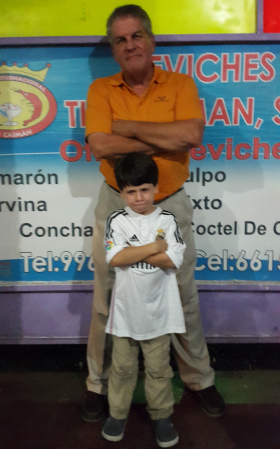

Jet: I understand that, to your grandson, you are “Allo.” How did you get that name?
Gonzalo: No. My wife’s name is Valli. When my grandson tried to say Valli, he said, “Ayi, Aayi.” He was around two years old then. So she’s “Ayi.” Then I became “Allo,” because he couldn’t yet pronounce my name, which is Gonzalo. Usually, your first grandkid is the one who gives you your nickname, you know. So, to all our grandkids, I’m Allo and my wife is Ayi.
Jet: How was the trip to your ancestral home?
Gonzalo: Some of my kids haven’t been to that area of the family beginnings in Panama, so on my birthday in November, I took my children and my grandkids, and I said, “Let’s go back and have a tour of the old days.”
Jet: How many among your family came to celebrate your birthday, Gonzalo?
Gonzalo: Oh, we were about 17! We stayed at Cubita, which is a very nice boutique hotel in the Interior, in the town of Chitre, which I think is about half an hour from all the places we wanted to see.
(Gonzalo de la Guardia with grandson in identical postures during a Saturday excursion, pictured above.)
Jet: What did you see?
Gonzalo: First, I took them to the town of Las Tablas. Las Tablas is a very folkloric place in Panama.
Jet: Do you have a personal history in Las Tablas? Did you used to go there as a young man?
Gonzalo: Every Panamanian has been to Las Tablas. It is the center of carnivals and folklore. There you will see the traditional dresses of Panama – polleras. It is the cradle of our history.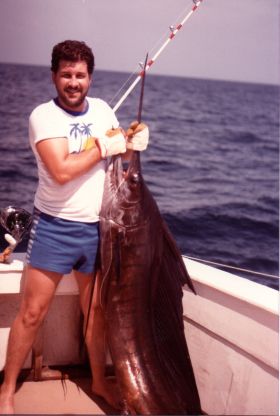

Jet: Can you tell me a story of something interesting that happened to you in that town when you were celebrating carnival?
Gonzalo: The first time I went for carnival (and I am not a very “carnival guy,” because I don’t like the non-stop partying), I had a great time. We were young, about 17 or 19. We used to go with my brothers and friends.
(Fishing in Panamanian waters in 1981, Gonzalo de la Guardia pictured right with his impressive catch.)
Jet: What was it like in Las Tablas during carnival?
Gonzalo: It was all dancing and partying for hours on end. We were dancing at the parks. There is music; they put together new songs every year. All the queens – there are two queens: the Queen of Calle Arriba, or the queen of the high street and the Queen of Calle Abajo, or the queen of the low street. They have a match to compare and see who has the best dress. It is a friendly competition and it is beautiful. They dress up their magnificent carriages, too. It is like a 11-hour, non-stop party from 7 PM to 6 AM.
Jet: Have you taken the grandkids there?
Gonzalo: Oh, no, no, no. Carnival in Las Tablas is for adults.
Jet: When you went to Las Tablas with your family in November, where did you go and what did you want everybody to see?
Gonzalo: I wanted them to see the museums. For example, the La Casa Belisario Porras Museum. Porras was one of the caudillos of Panama. A caudillo is a political figure; an important political figure, one of the famous guys. He was president of Panama twice.
Jet: Why do you admire him?
Gonzalo: He was very important in the first days of the Republic and he was a very dedicated man. He added a lot to our institutions in Panama. He studied in Europe and he came back to Panama. He was a very well-known patrician in Panama.
Jet: What other place did you visit in that area that you wanted to show your family?
Gonzalo: We went to Porras’ summer place. It is around half an hour from Las Tablas where he had his weekend place, and now it is a museum, which is gorgeous. It is a wooden house with French architecture in the middle of a ten-hectare (about 25 acres) finca. A finca is a ranch outside of town. They made a replica of his house, as it was, and they have small employees’ houses. They planted trees, like pine trees, etc. It’s beautiful. I have pictures!

Jet: Oh, yes I am going to ask you for pictures of everything we talked about.
Gonzalo: Sure.
(Gonzalo de la Guardia giving grandson Tommy a view of the world from his shoulders, pictured right.)
Jet: When you spoke to your grandkids about President Porras, what did you say about him that you wanted them to know as a part of their history that led him to be a good Panamanian?
Gonzalo: It is important to know who the forefathers of our nation were and how they got to that place. The forefathers had good influences in their education. They studied a lot. Porras studied a lot. He went to universities overseas and came back and brought all that culture with him. He saw other things in other places and he tried to import them into Panama.
The thing I wanted to tell my kids, is the best education in the world is to travel, and not only overseas, but also within your own country, because you will see things and you will incorporate them into your system.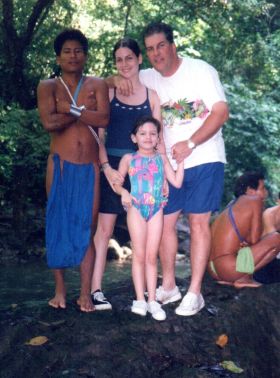

(Family trip to the jungle home of the Embera Drua tribe 1999, pictured right.)
Jet: What about your education when you were growing up?
Gonzalo: In my family, we attended and studied in primary and secondary schools in Panama City, which were excellent. We went to a Christian brother’s high school called La Salle. There are some La Salle schools in the US, also. They are Catholic brothers who dedicate their life to education.
Jet: What made you think that you should go to the United States to study?
Gonzalo: We always looked forward to going to the US to study.
Jet: Did your family have American friends?
Gonzalo: Oh yes, my father grew up in the US. This is a pretty interesting story.
Jet: Please tell me.
Gonzalo: My grandfather was born around 1882 and at that time, Panama was still part of Colombia; we became independent from Colombia in 1903. So when my grandfather was born, he was born in Panama, but Panama was just a province of Colombia. When he and his brothers were teenagers, a terrible war started in Colombia. It was called the War of a Thousand Days.
Jet: What is the Spanish translation?
Gonzalo: Guerra de los Mil Dias. The conservative party and the liberal party had a bloody war. When the war started reaching Panama, they were recruiting small teenagers. So my great grandfather decided to move his family to California.
Jet: Where did he get the idea of moving to California?
Gonzalo: Panama and California have had strong ties. Why? Because a lot of the people who moved to California during the Gold Rush went through the Panamanian railways. There were boats going into California all the time. My great grandfather took his kids to California and over there, my grandfather studied in college. He went to Santa Clara University in Pasadena. They stayed there for seven years.
Jet: Was there a Panamanian community in Southern California that you know of?
Gonzalo: They would probably be the only Panamanians at that time. My grandfather was 16 and he came back when he was already 24.
Jet: Why did he come back?
Gonzalo: When the Colombian Civil War ended, and at the end of their university days, they came back. Over there, my grandfather married Mary Galvin, my grandmother.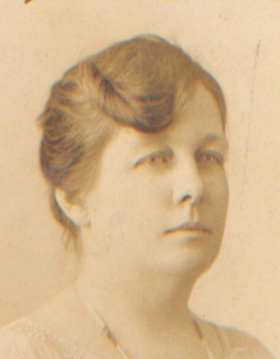

(The lovely Mary Gavin, Irish-American grandmother of Gonzalo de la Guardia, pictured.)
Jet: Sounds like an Irish girl!
Gonzalo: An Irish girl, of course! She’s very beautiful. What a beautiful woman. We have pictures of her. She was beautiful with blue eyes. Gorgeous woman.
Jet: What about your grandfather, what are his features?
Gonzalo: Oh he’s just like me, a Panamanian!
Jet: So, he has the square jaw and very Spanish features. Was he a Gonzalo, too?
Gonzalo: No, Eduardo.
Jet: So, Don Eduardo.
Gonzalo: Don Eduardo! That’s right. Don Eduardo married Doña Mary. And then they moved back to Panama.
Jet: Where did they settle?
Gonzalo: In the middle of Panama City. In Panama City, people used to live in Casco Viejo, the old town.
Jet: What streets? What intersection?

(Gonzalo de la Guardia and grandson visit the old neighborhood in Casco Viejo, pictured right,)
Gonzalo: Plaza Herrera.
Jet: Oh, I know Plaza Herrera. So they had an apartment there?
Gonzalo: They had a house there.
Jet: And is it still a family home?
Gonzalo: No, it was sold. I don’t know to whom, many years ago.
Jet: It is still a family home or a business?
Gonzalo: Somebody is remodeling it. You know that sector is being remodeled block by block. So in a couple of years it’s going to be amazing.
Jet: Did you visit that home when you were a kid?
Gonzalo: No, I was born outside of Casco Viejo. I am one of eleven brothers. I am number six, so I am the axis of the family. I was born outside of Casco Viejo. My family moved to the suburbs in 1951. I was the first one of the brothers to live in the Cangrejo area, and I was the first one to be born outside of the Casco Viejo.
Jet: How would you describe the Cangrejo area?
Gonzalo: In those days, it was wonderful. It was like living in the outskirts, in the countryside. My father’s house was the second house built in that area.
Jet: When you say it is like living in the outskirts, was it in the jungle or by the
water?
Gonzalo: It was in a finca. It has grasslands where you will see one house here and another house over there, but pretty soon, it became just a community.
[Editor’s note: The Congrejo district is now part of metro Panama City.]
Jet: So tell me, as a boy, what kind of games would you play in the Cangrejo?.png)
.png)
(Puffing happily on cigars with friends and members of the Cigar Aficionados of Panama, pictured right with Gonzalo de La Guardia.)
Gonzalo: We would run all over the place and play “wacho.”
Jet: How do you play wacho?
Gonzalo: We get 4-foot sticks and create a puddle on the ground and then we would count, “1, 2, 3, 1!”
Then, whoever knocked the other stick will get to play with it and we would throw it around and hit the other stick. The other person will go and get the stick. In the meantime, we have to drop our sticks in the mud five times and count, “1, 2, 3, 4, 5, out!”
Jet: That was fun! Are you still able to keep in touch with your childhood friends or is everybody all over the world?
Gonzalo: I know them all. They are all married and have moved on from that neighborhood, but we all know each other. We went to school together. We are very close by and we still keep in touch with each other. That is one of the good things about Panama City. It is still a relatively small town with under two million people.
Jet: You know what US high schools are like. How are Panamanian high schools different? How are the activities? What are the expectations of the kids and their parents?
Gonzalo: I can tell you how it was in my days. The school I went to in Panama had an extremely disciplined environment. We respected the teachers, especially because they were Christian brothers. The education had amazingly high standards. In high school, we took not only arithmetic, we also did geometry and calculus, so when I went to college in the US, I had already taken most of the first year subjects. On top of that, we had to take at least four sciences, which were biology, zoology, chemistry and physics.
When I went to college in Austin, Texas, one of the requirements was to take a science course, but I had already done all of them, so I said, “Let me take something that I have not taken in high school.”
So I took geology. It was fantastic. My geology subject was amazing because I was learning something that I had not learned before.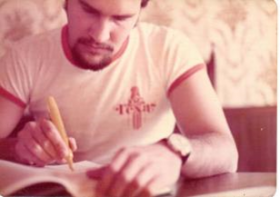

(A young Gonzalo del la Guardia as a student at the University of Texas, Austen 1971, pictured right.)
Jet: Are you oriented that way? Do you like the sciences?
Gonzalo: Yes, I like the sciences, just as an interest, but not as specialty. I have my master’s degree in economics.
One thing that I get every week is The Economist magazine; I download the audio edition. One of the first things that I do is read the science section.
Jet: You must have taken your grandson to all the Smithsonian Institutes around Panama?
Gonzalo: All my children, I took them to Barro Colorado.
Jet: Can you describe that for everyone?
Gonzalo: Barro Colorado Island is a marvel of science. Most of the Panama Canal is a man-made lake. When they created the Canal, they just closed the river, which filled up the lake, so all of the hills in the area became islands. One of the largest islands was Barro Colorado. So when the water was going up, all the animals in the area ran up to Barro Colorado, making Barro Coronado a reservoir of animal life.
The interesting thing about that is, that there was this fellow in the 1920s, I believe, who was going through the Panama Canal, who was a scientist, I believe, and he said, “Why don’t we create a scientific community and protect Barro Coronado for the next generations?”
Jet: How big is Barro Colorado and where is it relative to the Locks?
Gonzalo: It is in the middle of the lake, three hours from the Locks, very isolated. They created this special law to conserve Barro Coronado. Since the Smithsonian Institution has been running it for about 80 to 90 years, what they have done is first of all, keep it, as is. For instance, if you are visiting and you are eating an orange, you are not supposed to drop seeds, because they are foreign to the place. Then because it is a unique site, they invited scientists from all over the world to do research on tropical issues.
Jet: Is there a ferry to get there?.png)
.png)
(The De la Guardia family beneath a giant tree in Barro Colorado, Panama, pictured right.)
Gonzalo: They have a special boat to take people over there and they only accept around 30 people a day, but no more than that. They keep it very well controlled, so that it is not run over.
Jet: What does it look like?
Gonzalo: It’s a jungle. There have been scientists who have been coming back every year for 20 to 25 years and they are studying, for example, an ant that eats a special fruit or things like that. They go every year and see their anthills. It’s spectacular.
Jet: What do you see when you go there? Do you hike on a trail?
Gonzalo: You see animals. You go on the trails and you’ll see these humongous trees and animals all over the place, and you just walk through the jungle, which I mean a real jungle. It’s humid and there are all sorts of insects. It is just fantastic.
Jet: What are the geological features of Panama that makes your scientific heart beat faster?
Gonzalo: There is a recent theory that Panama was raised out of the water about three million years ago. And when that happened, Panama closed the gap between North and South American and created a separation between the Atlantic and Pacific oceans.
Jet: It’s a land bridge.
Gonzalo: It’s a land bridge. It changed all the courses of the water in the ocean, and there is a theory that thanks to this, the weather changed and the savannah of Africa started to develop. That area in Africa changed because the change of the weather that was triggered by the rising of this land bridge.
According to this theory, if the weather had not changed, we would still be jumping from tree to tree in Africa. This weather changed the savannahs in Africa, so our ancestors came back to the savannah, and human evolution jumped some notches.
Jet: How else is the country of Panama taking part in the scientific community?
Gonzalo: We just opened the museum of biodiversity in Panama City, which was designed by the famous architect Frank Gehry.
Jet: Oh Frank Gehry! Oh my goodness, what is your opinion of it?
Gonzalo: Oh, it’s different! It’s big! Actually, there are many cities in the world asking Frank Gehry, “Please, please, we want you to do something for us.” And you know why he did one in Panama?
Jet: Please, tell me.
Gonzalo: For a very powerful reason.
Jet: Because he fell in love with a Panamanian woman?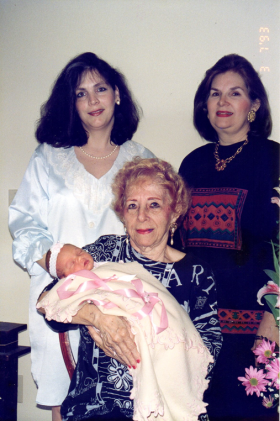

(Four generations of the the beautiful De La Guardia women, pictured.)
Gonzalo: You’re sharp! He’s married to a Panamanian. I don’t know where they met, but maybe in Canada. I guess she asked him to put Panama on the list. The museum just opened about six months ago. It’s just gorgeous.
Jet: Can you imagine if you sent more Panamanian beauties out into the world to meet international movers and shaker to bring them back to Panama?
Gonzalo: Oh, everyone will be surprised!
Jet: How can you identify other Panamanians when you are outside of the country?
Gonzalo: There are two ways you can find out. One thing that will come to your attention is that they talk with their hands. We’re very expressive.
Jet: Like Italians?
Gonzalo: Yes, like Italians. And the other thing is the accent. I can tell the Panamanian accent anywhere.
Jet: Tell me a word with Mexican accent, and maybe even a Columbian accent and then a Panamanian accent.
Gonzalo: The Panamanian accent, you’re already listening to right now.
Jet: Of course!
Gonzalo: Mexicans, they sing a bit more –“O, mi amigo… Come esta usted?”
Colombianos are more like the Spaniards. They are Castilian sounding.
Panamanians are a mix of Latin and Caribbean. It’s difficult to explain an accent.
Jet: What did you miss about Panama when you were going to school in Austin, Texas?
Gonzalo: Panama is such a mystery. Panama is such a wonderful place. People are special here. I have had the experience of traveling throughout Central America, and there are wonderful countries. I love Guatemala, for example; just the beauty of the place is fantastic. But Panamanians have something different. We are peaceful people.
Jet: Why is that?
Gonzalo: Because we have never had civil wars. When you have a civil war, it leaves a lot of anger and resentment in societies. Something like, “Your brother, killed my brother… your cousin killed my cousin.” That is inevitable in civil wars.
Jet: Is this your theory, Gonzalo?
Gonzalo: Yes, it is my theory.
Jet: It is a very good one. What more?
Gonzalo: Panama has never had a civil war, so I don’t think there is inherited violence in our communities. Of course, there are drug gangs like anywhere else, and that is another history. But the common people… when you go to the Interior, and let’s say you get into a car accident, everyone is nice to you.
Jet: What else makes Panama wonderful and special?
Gonzalo: I think the weather. The beauty of the place. For example, one of the things I love is playing golf. What I am saying is why golf is important in so many people’s lives. First, you are walking and standing for hours in a beautiful place. Golf courses are gorgeous, right?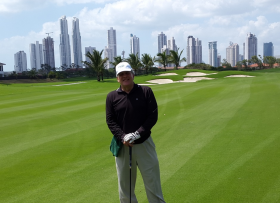

(Gonzalo de la Guardia on the greens at the Santa Maria golf club in Panama City, pictured.)
But any golf course anywhere is a special place. They are beautiful. I like the golf course for the same reasons I like my country. It’s beautiful. There are people I like. And I think that I could not live anywhere in the world as well as I live in Panama.
Jet: Why did you decide to bring your family back to Panama?
Gonzalo: I’ve always lived here; I only studied in the US. I went to school in Austin, and I did my four years in college, then I went to London for four years, then I came back to Panama. My plan was always to go back to Panama.
Jet: Is your wife from Panama?
Gonzalo: My wife is from Panama, all my eleven brothers and sisters live in Panama City, and we see each other. We are six brothers and we make a point of seeing each other every week.
Jet: That is beautiful.
Gonzalo: My mother was a very interesting and intelligent woman, and she once told me, “In order to love each other, you have to see each other.”
Interesting, yeah?
Jet: Yes. So how did your mother arrange these constant meetings?
Gonzalo: My mother died eleven years ago. But for as long as my parents were living, we used to have family dinners every Thursday night at their home.
In the beginning, there were only thirteen of us. But then we got married, and all our families came to the dinners, too. So in the end, it was around thirty people with all these kids.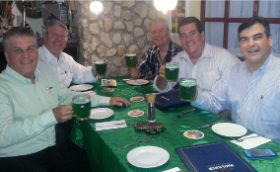

Jet: How did your mom fit thirty people around one dining room table?
Gonzalo: Our dining table would seat sixteen people, but then we had an additional table. We also had dinner in the backyard. We had waiters and everything. It was a big thing!
(Traditional St. Patrick's Day gathering for the close De la Guardia brothers, pictured right.)
Jet: Who would do all the cooking?
Gonzalo: My mother had cooks at home. One of the advantages of living in Panama was she had helpers. My mother’s kitchen help would cook for all of us.
Jet: How big was this kitchen?
Gonzalo: Big. It’s probably 70 square meters (about 750 square feet).
Jet: This is my curiosity. What is a Panamanian kitchen like?
Gonzalo: It’s a different concept. It’s a very interesting question. Our homes, in the old days, and still now, we used to have maids and other people who would live with us.
Jet: Are these young women or are these women who are widowed?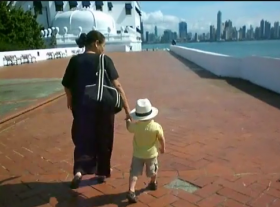

(Grandson Jaime in Panama hat with his nanny touring seawall of the Casco Viejo, pictured.)
Gonzalo: Some of them are young women. For example, our nanny arrived at our home when she was 22 and she worked with us for 42 years.
Jet: She never got married, Gonzalo?
Gonzalo: She got married, yes. She had one girl, who we put through school.
And the kitchen in a Panamanian house was outside of the house.
Jet: What do you mean “outside the house?” Is it in a separate building?
Gonzalo: No, it’s in the same building, but behind closed doors.
I lived in Seattle for five years with my wife and kids, and in the center of the house was the kitchen. That’s where we would be cooking, and the kids will do their homework on the table, so the kitchen was the center of the house, and it was open.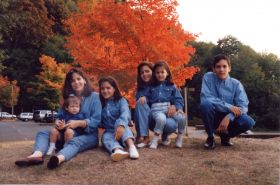

(The growing De la Guardia family in Seattle, Washington 1991, pictured right in all denim.)
In our houses in Panama, since we don’t cook, the maids cook, the kitchen was behind closed doors. I like the open kitchen because you participate more. But nowadays, with all the new buildings in Panama that have been built, a portion of their target market is expats. But the expat community does not want anybody living in their homes with them, even maids. They just have somebody who cleans. So their houses now in Panama are American style. Everything is open. We now have open kitchens in Panama, which are part of the house.
Jet: At your family dinners, what other traditions did you have? What time was dinner?
Gonzalo: Dinner was usually 7 PM. My parents would all be sitting in the backyard, and we all would go to them and give them a kiss as we arrived. My mother would, of course, be organizing everything with the maids, and whatever the menu was, etc. And the kids were running around in the backyard.
Jet: Describe a Thursday meal and the courses. Did the children sit with their parents or did they have a section that was different.
Gonzalo: No, we all sat together. The kids, when they’re small would be with their nannies, running around. Dinners would usually be barbecue steaks, rice and beans and corn. Sometimes, it would be seafood..jpg)
.jpg)
(A Thursday gathering and dinner at the De La Guardia home with Gonzalo's loving parents in 1981, pictured right.)
Jet: Would the maids cook the barbecue, or is it like in the United States, where it is primarily a man’s task?
Gonzalo: If it was barbecue, one of the brothers with the meat would do that, while the rest of the food would be done in the kitchen.
These family gatherings were just to show how important it was for us to see each other. Now that my mother has passed away, all of us brothers and sisters do not get together every week, because nobody wants to take on that task. So what do the brothers do, the six of us, every Friday? We get together for lunch, and afterwards, a cigar.
(De la Guardia and his brothers with their weekly after lunch cigars, pictured below.)
Jet: Oh, I’d love to see that. And the cigars are from where?

Gonzalo: I happened to be the president of the Cigar Aficionado Club of Panama.
Jet: What are you smoking these days that you like? How would you describe it?
Gonzalo: We get very high quality Cuban cigars, Behike and Monte Cristo. But I particularly like Nicaraguan cigars, like Rocky Patel, which is a very well-known brand in the US. I like the well-known cigars.
Jet: Now that we are coming into Easter, please tell me what it’s like for you and your wife, and when you had children, what was it like for your family?
Gonzalo: On Ash Wednesday, we receive the cross on the forehead. And then the night before Easter, on Saturday, we go to church. And on Easter Sunday morning, we go to church again. Then we have the eggs for the kids on Sunday.
Jet: So even in Panama, you have the egg hunt, too?
Gonzalo: Oh yes, in the backyard. And the supermarkets and the pharmacies are full of all sorts of chocolate eggs.
Jet: I’ve heard that Panama has changed so dramatically. What do you show your grandson and say, “This is different.”
Gonzalo: I do it by themes. I organize themes.
(2011 video of the old town and the bulwarks against pirates taken in Casco Viejo, part of the the Sabados con Allo collection, above.)
Jet: I’ve seen the video taken in Casco Viejo. It was beautiful.
Gonzalo: I have around 10 or 15 videos. I do it by themes, for example, “Chinese Day with Allo.” So I take my grandson to dim sum in the morning for a Chinese breakfast in a Chinese restaurant.
Jet: What is the Chinese community like in Panama?
Gonzalo: We have very old ties with the Chinese community. There is a very strong Chinese community that has been here in Panama for more than a hundred years.
Jet: What impact do they have?
Gonzalo: They have a very important impact in Panama. For example, they even have their own schools nowadays. They have a work ethic that is second to none. They are good students, hardworking people, and very good entrepreneurs.
Jet: What kind of businesses do they tend to go into?
Gonzalo: The old guys have stores. The newcomers, like the Koreans in the US, have stores, too. They come here with nothing and open small stores, and in ten years they have money, they have businesses, they have houses; their kids go to the best schools.
Jet: What kind of stores and businesses do they open?
Gonzalo: They have hardware stores; they have stores with fabric they have imported through the Colon Free Trade Zone. They have import and export.
Jet: What did your grandson find fascinating about his Chinese theme day?
(China in Panama, presented by Gonzalo de la Guardia and starring little Jaime, above.)
Gonzalo: First of all, the food was fantastic, and eating with chopsticks was fun. After that, we went to the Chinese-themed park, which has Chinese fountains and bridges and buildings and it is next to the Chinese school.
After that, I took him to the Chinese village inside Casco Viejo. I filmed everything, so now when he comes home, he says, “Allo, Allo put on the Chinese day!”
Jet: What kind of satisfaction do you have putting together these little productions on Youtube?
Gonzalo: First of all, it takes me ten hours to do those things. They come out right, but I’m not an expert, so it takes double the time. It’s just a wonderful, because these kids grow so fast. I’m just filming them as they grow up.
One day I’m not going to be here, and my grandson will look at those films and say, “Oh my goodness, Allo really took care of me.”
Jet: Is there anything that in your travels that you should have mentioned that is significant, but maybe did not mention in your films of Panama?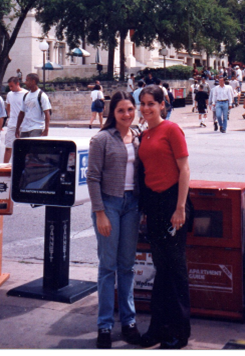

Gonzalo: I had the opportunity of living overseas. I have lived in the US for many years – four years as a student in Texas and five years in Seattle, Washington.
(The second generation of De la Guardias at the University of Texas campus, pictured right.)
Jet: How old were your kids when you lived in Seattle?
Gonzalo: They were eight, seven, six, four, and two more were born over there. Then I studied in the London School of Economics in London for two years. Those things really made a difference in my life, living in a different place, learning new cultures and new languages. Because in Panama, I only learned English in high school and it was very limited. When I went to the US, I learned the language and I learned the culture. It was the same in England.
You incorporate those things into your life, and it does make a difference because you see the world as a different place. There are so many differences all over the world – how people speak, how people act, how people eat, everything. And the true experience is to experience and to celebrate the differences, to enjoy how different things are. It is something different, but it is something that I can learn from. Traveling is the best education in the world. I did have my chance of traveling and studying overseas.
Jet: And your kids, what are their ages now?

( The acconmplished De la Guardia's daughters in 2015, pictured right.)
Gonzalo: 33, 32, 31, 27, 23, and 21.
Jet: So did any of them go back to the United States to study in college?
Gonzalo: Oh yes, they have all studied in the US for college. Two of them went to University of Texas; they are Longhorns also, like me. The other one, she went to Florida State University, and then listen to this, she just finished four years getting her PhD in genetics at the University College of London.
Jet: Wow!
Gonzalo: That is what I try to tell my kids. I appreciate when they have at least my same grade of education – a master’s degree, but I think they will go to the PhD.
Jet: Your grandfather would be so proud!

Gonzalo: Oh, yes. I think it is just natural for them to think, my father went to London School of Economics and he has a master’s degree, so it is natural that I should have the same degree or more. So they all have. All my kids have masters’ degrees already, one has a PhD, and one is in medical school. Oh, that’s what fills my days.
(Baptism into the Catholic church of Amalia, daughter of Gonzalo de la Guardia's son, pictured right.)
Jet: That’s great! So what do you project for the future of Panama or for the generation of your children who are starting and are into their productive years? How do you see them integrating into this new fabric of Panama that is doing so well?
Gonzalo: Oh, they have so many opportunities to develop their talents. One thing that is important to me about Panama is that this is not the most important place in the world, for sure. This is a tiny place, but for us, it is important because Panama is kind of an oasis in the middle of a desert..png)
.png)
(Gonzalo de la Guardia with his beloved grandchildren viewing the expansion of the Panama Canal, pictured right.)
Let me rephrase that. When you see Panama’s neighboring countries, everything in life is relative and relative to our neighbors. We have a more energetic economy for the time being. We have a more peaceful society for the time being, and I hope it stays like that. I think that a lot of our neighboring countries look up to us. The same way we might look up to Europe, for example. Panama is attracting a lot of attention from South Americans who want a place where they can escape. One of those countries is Colombia.
I love Colombia. It is a wonderful country, but for some years in the past 20 years, they have had security issues. So if you are a father and your kids are in danger of being kidnapped, at least you have a place like Panama, where you can send your kids to school. And that’s what a lot of them did. They bought an apartment in Panama. But that is over because Colombia now is in a much more secure place than it was 20 years ago. We have been that place of refuge for a lot of people.
Panama is a welcoming place. Since the Spaniard’s days 500 years ago, Panama was a place of transit. People from Europe came to Panama, and from there, they went to South America. Panama has been a place of transit for 500 years. We have had expats for 600 years. To us, it is very natural to see a Hindu, a Chinese, a European, and an African. It’s natural because we have seen them all our lives. In that sense, Panama is very welcoming. I have a lot of expat friends and they tell me all the time that they feel very welcome and at ease in Panama. That is a good feeling because I have been an expat. I was an expat in the US and I was an expat in London..png)
.png)
To be welcomed in a foreign country is just a wonderful feeling.
Jet: Thank you so much for this interview, Gonzalo. I want to see is you with a cigar looking content – a man on top of the world, OK?
(Dapper Gonzalo De La Guardia business man, president of the Cigar Aficianados of Panama and family videographer, pictured right.)
Gonzalo: I have that!
Jet: Thank-you, Gonzalo. Thank-you for this warm and insightful interview. Long live the De La Guardia’s of Panama!


